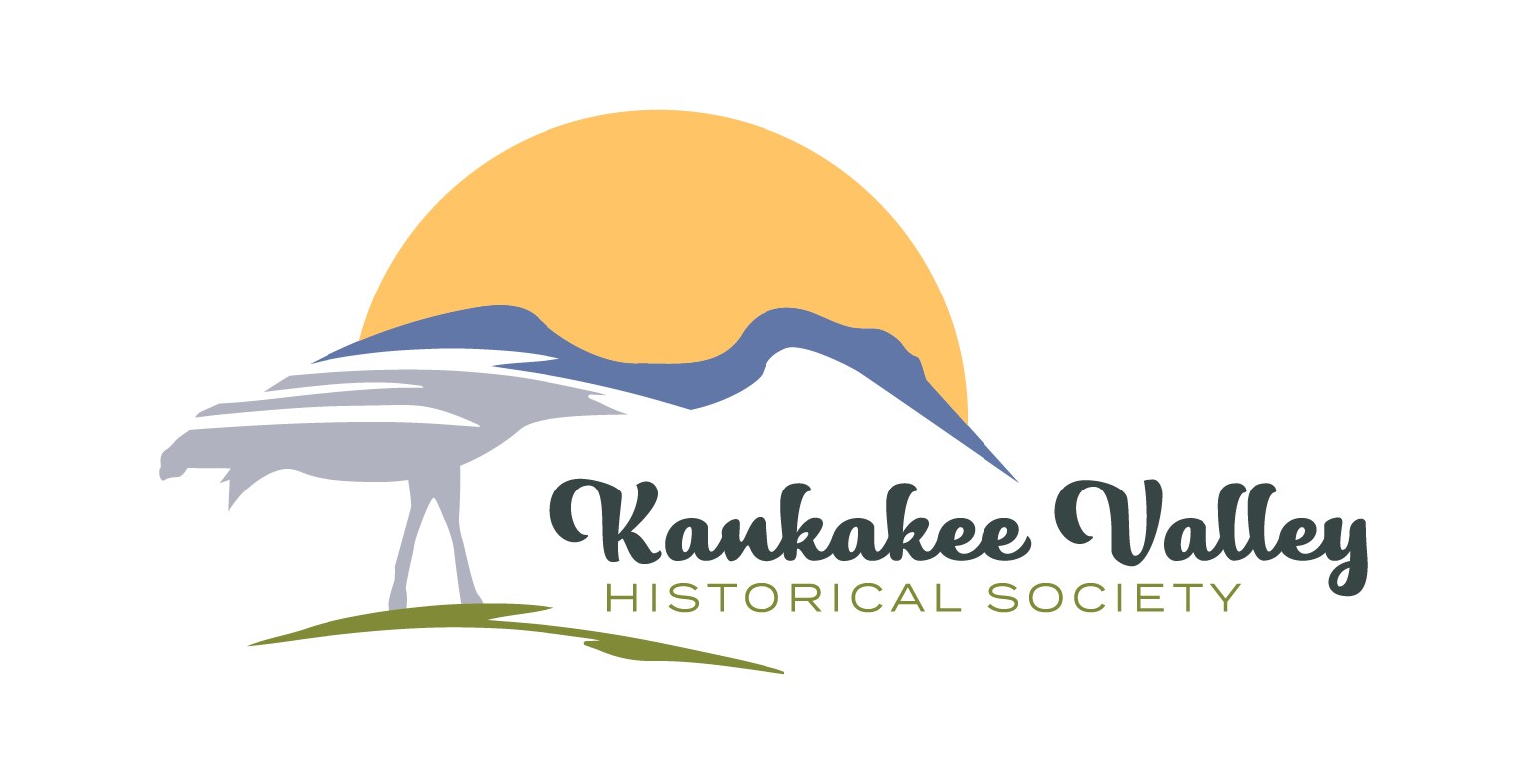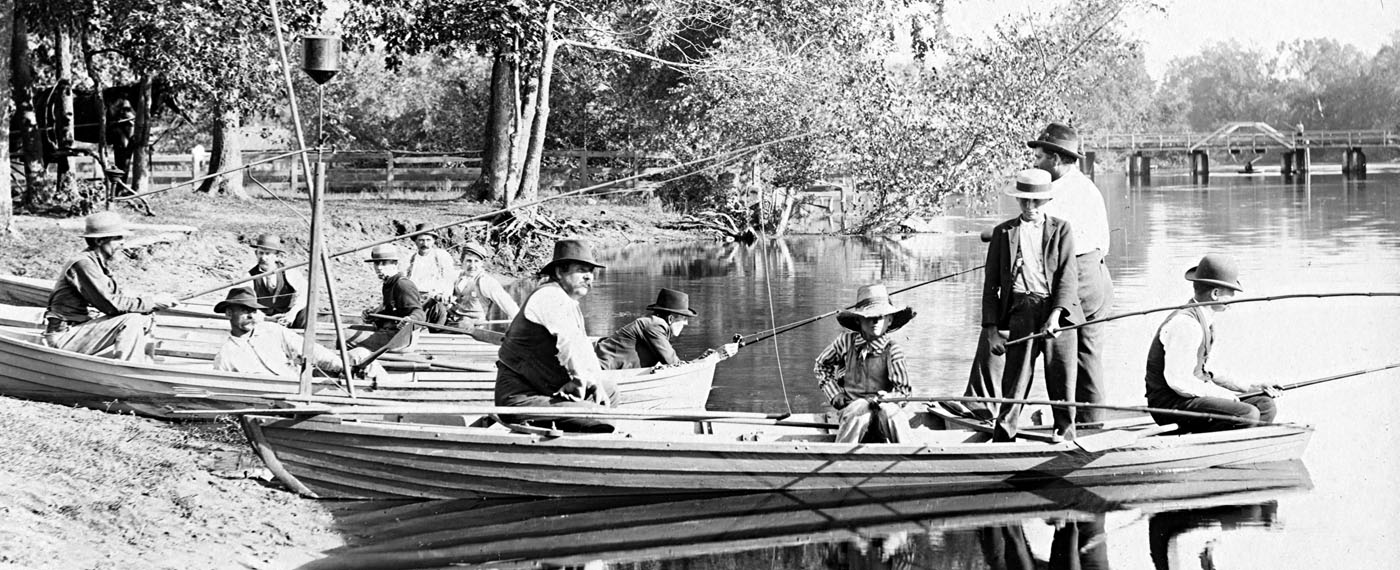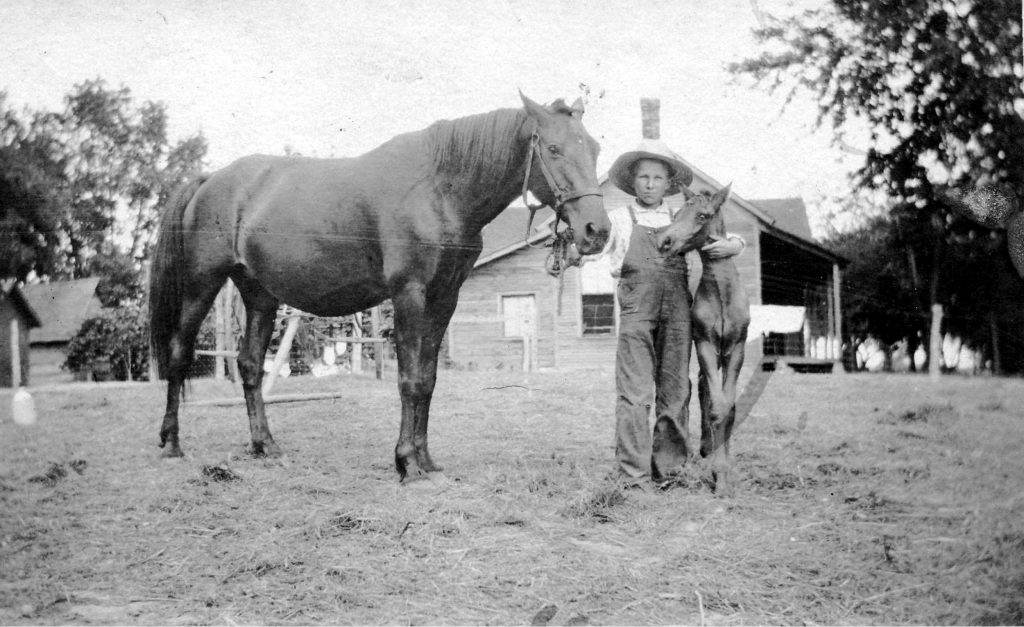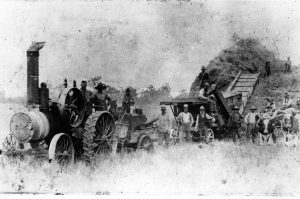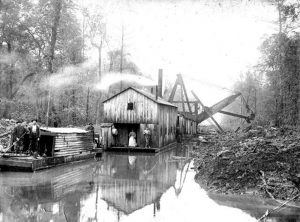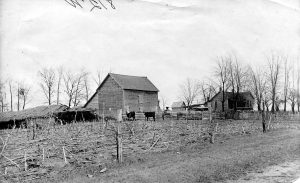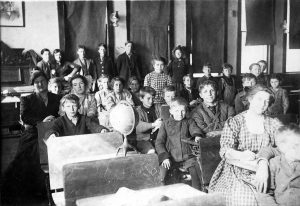Casper Belstra
THE SETTLING OF THE GRAND MARSH OF THE KANKAKEE RIVER
Interview by Laverne Terpstra, Transcribed by Shirley Zeck
March 30, 1992
I was born in the Netherlands, in the northwestern province of Groningen on July 5, 1895. I was 9 ½ years old when I came to America. It was a scary trip. I was seasick every minute. They told us it was going to be a stormy trip. It was on a boat of the Holland-American line named Stattendam. I don’t remember how many days we were on the ocean, but it was quite a trip and we were happy to see land. My brother Simon was never sick a minute. A buddy he played with said, “The rougher it got the better he liked it”.
Grandma and Grandpa Nannenga and two boys moved here around the Calumet Lake. They stayed there for a little while and then moved to DeMotte. A Dutch colony was started here. They decided to call us to say we could do better in this country. In the Netherlands we had our own place, four acres, a good house and a big barn built right to it. We were doing pretty good. My father decided to immigrate, he was going! His sister did not want to leave, (she thought it was a waste of money), so she was left behind. We arrived December 4th and landed in Thayer. That was the end of our journey. Uncle Jake Nannenga met us at the train. We stayed with Grandpa and Grandma that winter at their farm. And that spring Dad rented a farm (Kingma’s ) -8941 W 1000 N). We didn’t live right there. It was an old house that was right around the corner, south and west, on the north side of the road and not too far from that corner. There were no barns, no barns whatsoever. There had been a sawmill there and a lot of slabs were left laying around. My father took these slabs, set them up one against the other and that was his barn.
We didn’t have much money. Uncle George Nannenga had to help Dad in everything he was doing because Dad never learned to speak English. George Nannenga and he bought a plow on a sale, a walking plow. He bought two cows and he borrowed horses from Uncle George who lived across the road on a farm. He worked with him too.
I remember that first winter here. Dad got a job with Corneilus Evers Sr. baling stacks of hay and I hired out with him. They paid $2.00 a day, $1.00 a day and I got fifty cents a day. And I had to drive the press team around and around. The press team would get the hay and put it in the press. The horses came around and they drove pretty easy. They would get a roll and start over new again. I had to get the chain going, but at the same time you had to keep that team running. Corneil Evers fed the press and George Mosier, who was a steady hired hand with Evers, took charge of the wires for the cut hay and then it went to Chicago. Chicago was run with horses with no trucks or anything.
Marsh hay was baled. That’s all we had. It grew wherever you could get it. Some of it in the lower ground was too wet. In the winter time they cut hay over the ice. That was what they called packing hay. It wasn’t very good feed. It was baled and sold and that kept us going just about all winter. They shipped it by train. There was a man that really bought it in town. He was what you might call a mentor. That was Frank hart. Frank handled the buyers for that hay. I don’t know how much hay, I didn’t try to keep track of that. The hay was raked in wind rows and pushed with the teeth down and pushed it together and the sweep rake rolled it. One horse here and one horse there and they would raise the rake. They would take that to the press. It was a lot of work. There were different ones that pressed hay, but there were some farmers that put up hay for their own farm feed. My Dad did it. It was the way they done it. And in those days it was all the hay they had because it was too wet to farm.
Then we got ditches, dredged ditches. That started about the first year we came to the States and had that farm. There was a dredge already laid. The fellow that was to operate it came and built the dredge and they floated in water (the machine that dug the ditches). They had to have water and they had two long arms — four of them — and they moved forward and that way they could dig again. Someone would come in from another area to do the ditching. These ditches didn’t run into the river. They ran on into the marsh and after awhile flooded the marsh and made higher ground and of course, later on, not too much later on, they ditched the river. They made a ditch out of the river.
Again, they took these same dredges, spread it and finished that up to the river. That drained a lot of marshland. What we call the Old Marsh. When the river was high in the spring it was over a mile wide. Most of the flooded ground was on the south side of the river. There was a marshland on the north side too, but not as much as on the Jasper County side. Of course, they had trouble with it ever since. The Evers ditch was one of the first ditches (starts at 1000N about ¼ mile west of SR 10 and runs north). There were others, Hamstra, etc.
These ditches were named for the one who applied. There is a ditch called the Casper Belstra Ditch. I was the first one applying for it. Later on we had a DeHaan Ditch. It’s sand, in dry seasons farmers threw up dams right in the ditch to hold the water. There were several, butt that dirt made those ditches so shallow again and finally they couldn’t go through people’s yards to dredge these ditches. They would have to haul it out with something. They had all horses, no trucks.
We had no income except what we made from farming. See, we had just that one farm. But one fellow advised us when your cows had a calf, keep it, just let it grow. Hogs in those days ran together. Neighbors hogs ran together, no fences.
They preferred acorns to corn, especially when acorns were dropping. When evening came sometimes the farmers would call them. . .soo-e-e-e and they would come. One would stick his head up and snort a little and take off. They lived off the land, too.
While I was with the press outfit making fifty cents a day, shoes were only 89 cents, not even a dollar for a pair of shoes. Overalls were cheap compared to now. I always worked. When we lived in Chicago I worked there too. When we were in Chicago, Mama said, “I’m going to keep Casper by me”. The truant officer never went after me or anything. I just never went to school after the 7th grade. My teacher told me that I would be in the 8th grade. Those days when you moved, you moved the first of March. When we left Chicago, she told me I was one of her best pupils, and she said, “You’re going to be all right”.
It wasn’t hard learning the English language. For me it was a cinch. In the first place, we had the country school. It was the McKinley School. That was the last school that was for our district. It was located right where Sammy Hamstra lives on the hill (1100 N & 900 W on the south side of the road). In those days one teacher taught eight grades and a good teacher made it stick. Sometimes it went pretty rough. As far as the teacher is concerned, lots of them were women, but there were some men. My first were men. My very first teacher was Otto Schwanke in the one room school. All of the children, with the exception of one, were from the Dutch descent. I liked to read and learned the English language from reading with the help of my teacher. The state started a traveling library which started with our school. There were quite a few books. I read them all and I read them all more than once. I was an avid reader, even today. I’ve always read. Between all them kids you know, they helped me, except one, Grace Mosier. She was the only ‘American’, we called her that. The rest were from the Dutch.
The cheese factory was located where Zylstra’s live (1229 S. Halleck Street). That was the time when farmers took their milk and separated it there. That lasted until they started manufacturing the little separators and each farmer could have his own. I would say this lasted about five years. The first cheese that was made there went east, it went to Fort Wayne, or a town near Fort Wayne and then later to Rockford, IL. A lot of the farmers would sell their cream (using their own separator). Later we had still another cheese factory and it was located where NAPA is (Old Ford Dealer – 1305 S. Halleck). Some farmers had as many as twenty or twenty-five cows, some of them had ten. I had twelve or fourteen. I never was much of a milker myself. Later on we got the milking machines.
When I first came to this area there were only dirt roads. Later they put stone on. They had a pretty good route from Chicago to this area. Then our milk went by truck. Before it went on the train. It went on the express car. Then, of course, that went either to Gary or Chicago; so that had to be transferred at Snyder and then they unhitched that express car (took it out of the train). That was a certain car in the train. They’d take that off and put it in another train that went straight north. That was all done by railroad. When we got the good route, trucks hauled it then. Something happened. We got in trouble with the truckers (the unions). They wanted to haul, we wouldn’t do it. We fought that and we got our way. There wasn’t much of helping each other build barns and homes, but there was some. There was a great big open shed. Then he had repairs for corn planters or most any other machinery. Something would happen to it and it broke down. We had corn planters, plows, hay rakes, mowing machines and some of the work was done by hand. In later years I had a hay loader. It would bring the hay right up on the wagon and throw it on. If you were in a hurry and didn’t have the help, men would go up there and load it. Men would throw it into the loader and the loader would bring it up into the wagon. That was in later years. At that time there was still all marsh hay. But when the ditches came that meant we plowed and put crops in. You forget about sand hills and so on when farming. We raised corn, (no soybeans) and timothy hay for the horses. Dad fed ear corn.
There was a pickle factory. It started the first year we farmed (1905), called the National Pickle and Canning Company. Squire Dingee was in Kersey, The National sold out to Clausen. National only had it a year or two and sold out to Clausen. Libbey McNeil and Libbey had a cabbage plant here that was on the track, behind him. They built their plant right there. It didn’t last long. But anyway, the first year I contracted twenty acres of white cabbage. they furnished the plants and you planted them. When the cabbage was ready to be harvested it was put into bins at the factory. Women cored the cabbage heads, then it was shredded and put into silos. Men packed it down with rubber boots on. They left their boots right there. It was all made into kraut. I think this factory lasted only three or four years.
And then another thing, Jake Nannenga, he was a “batch” you might say. He was living with his folks (we were living there too) and I’d tell him about these stories. Soon that made him interested. And then he said to me, he says, “You’re doing pretty good”. And I said, “Am I? Yah, that’s fun”. I can still remember some of those stories, storybooks.
There were 4 Kiersmas, 4 Terpstras, 3 Belstras and 1 Mosier; 12 in all at that time. Later on there were a lot more, they brought them in. The teacher—when school was taken up, you know, then each grade got his work and they were quiet while the teacher was examining you. Then he would work with one or the other. It seemed like a big job, but it wasn’t. I think it worked out. The only thing was some of the kids were unruly. You find that everywhere.
Mr. Keppelman (he was Dutch) had a general store. The stores had a little bit of everything, almost everything, groceries, hardware, except feed. They didn’t carry feed. Later on one of them did. The other store (there were two stores at that time), I can’t think of that man’s name, but it was on the corner. It wasn’t really a corner, but the end of the street, north. That’s where the railroad property started. The railroad had a square in there. That later became a road, but it never was a public road. When the railroad got rid of that property Konovsky bought it.
There was one store across (east side) main that was a feed store. that man handled feed and also hardware (not light hardware) but heavy hardware like plow shares. He had a pretty good line and if he didn’t have it he’d have it for you in no time.
“Little Ellis Island”, not too far away from our neighborhood. And that’s where a lot of our people landed that had no place to live. They made their home here in that building, sometimes three or four families. Then they would find them a place. North and east of DeMotte some promoters came in to get DeMotte started with produce sales, but it didn’t pan out. Well, they had that big building, farmers put their money in it and a lot of farmers lost almost everything they had. Some of the farmers went to put their land in their wife’s name. That way they would save what they had. That was a bad time for DeMotte. That was why the big building was built. Now there is another thing you don’t have. Then people helped each other during Spring and Fall if somebody was sick and couldn’t do their own farming. If it was time to plow or plant, the neighbors would all pitch in and maybe in one day or two they’d have the whole farm plowed and planted. They would celebrate, almost. The women cooked together at noon to feed the men. Then in the fall they did the same thing. When they picked corn for a day all you could hear was “bang, bang, bang” as the corn hit the ‘bang board’ on the wagon. That’s the way they helped one another.
Transcript of Taped Interview
With Casper Belstra
Interviewed by
Laverne Terpstra
Transcribed by
Shirley Zeck
Sponsored by
DeMotte-Kankakee Valley Rotary Club
Oral History Project
